In this case, I dug out my old Lumia 920, a classic and very solid smartphone from 2012, a whopping seven years ago. It launched with Windows Phone 8.0, got upgraded officially to 8.1 and was part of the original Insiders testing for Windows 10 Mobile, only to be considered as not fast enough by Microsoft. So end users never got offered W10M. However... what if you had a play with the next OS yourself and then forgot about the phone as it wasn't your 'primary'?
This is what happened to me and I powered the Lumia 920 on only to find it running Windows 10 Mobile branch 10586, from (circa) the end of 2015, and with no updates being offered by Microsoft, not even to the (also now out of support) Anniversary Update, branch 14393. Ah. Some work is needed here, then!
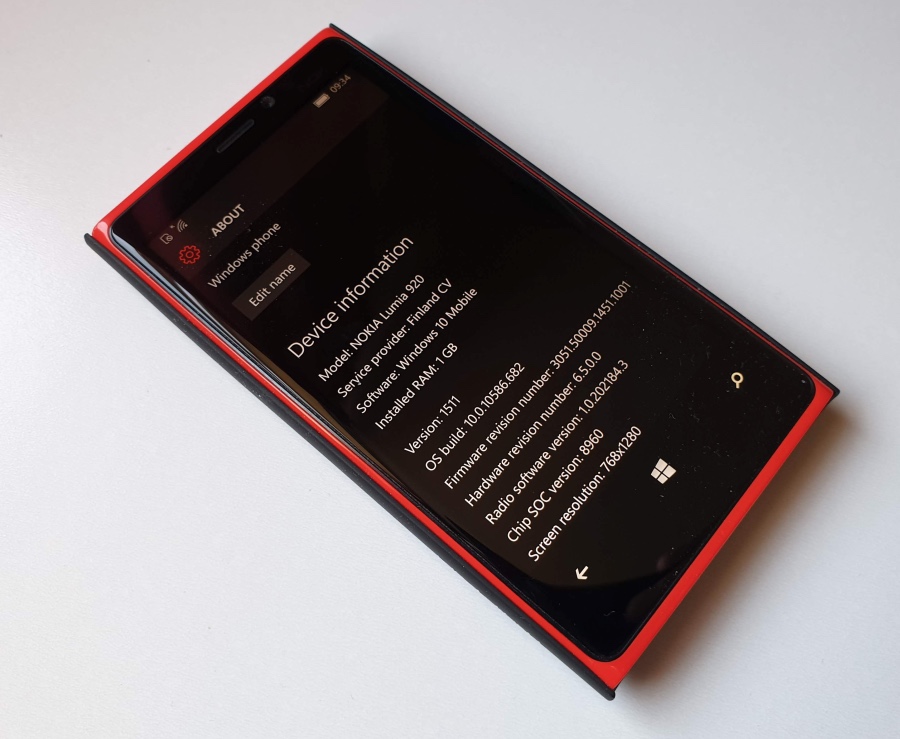
NB: if you're trying to do something similar, but starting from an even older OS, i.e. Windows Phone 8.1, then you'll need to do some extra steps to get to W10M, I refer you to the first part of this feature, from Spring 2017, almost two years ago.
The prerequisites, as usual, are:
- an older non-W10M-approved Windows Phone 8.1 device, ideally with 1GB RAM or more (e.g. Lumia 920, 1020)
- a Windows 7, 8 or 10-running PC
- unlimited free time and patience - really!
I'll save the usual disclaimers and caveats - if you're attempting any of this, along with me, then you're technically skilled and well aware of the risks. And if you're not, then run a mile - just buy a newer phone! I also can't emphasise the last point enough - it took me around 48 hours, on and off, working my way through the updating procedure, with several blind alleys and trial and error (and resets). With this feature, you may be able to halve this time, but it's still not a quick process!
I also want to emphatically emphasise that I'm not going to be tech support for anyone else following in my footsteps. Try the steps I used and see how you get on, but if something comes unstuck and you hit a problem then sorting it out is part of your own learning curve!
If you're happy to proceed then read on.
1. On the phone, I went to 'Settings/Update & Security/For developers' and selected 'Developer mode'.

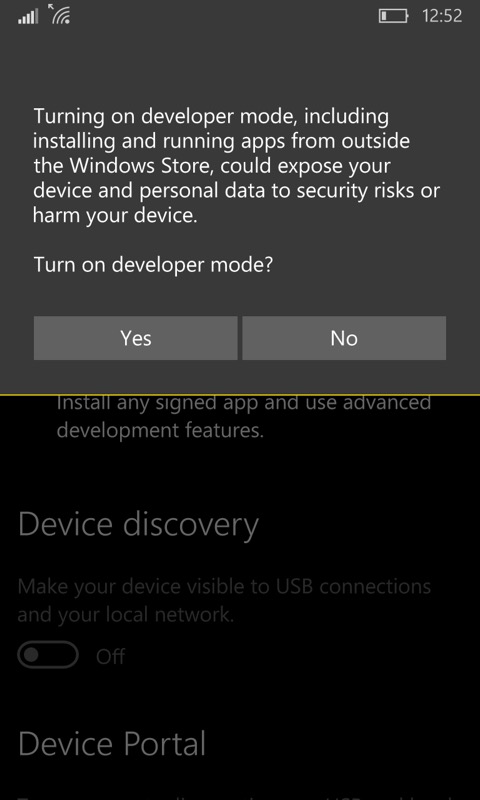
2. I grabbed the old Windows Phone 8.1 SDK application deployment utility, filename WP8.0 SDK Tools Lite Setup Av1.20.zip on my PC. Once downloaded, I extracted it all ran the .bat file supplied. This also took a while (loads of components are involved) and I needed to approve permissions every so often.
3. Still on the PC, I downloaded the vcREG 1.7 registry editor. It's a file ending in '.xap'. (the old v1.5 seemed to have disappeared)
4. On my Start menu, I ran the Windows Phone 8 Application deployment tool. I selected 'device' and picked the registry editor .xap file that I grabbed just now:
.png)
5. With my phone connected and the screen turned on and unlocked, I clicked on 'Deploy'. Nothing appeared to happen, but the status showed as 'Complete' after a few seconds and then vcREG appeared in the apps list on the phone.
6. I ran vcREG, tapped on the '...' menu and then on 'classic unlock'. I checked 'Live Interop' and 'Restore NDTKsvc' and then on 'Apply'. My old Lumia 920 was now 'jailbroken', to use the iPhone jargon. And the registry was unlocked:


7. Back on the PC, I downloaded 'Interop Tools' from here, I went for downloading the stable v1.7, since I had issues with newer versions (v1.9 of the app would crash with no useful information - probably something I'd done wrong, but hey).
8. Using Explorer on my Windows PC, I copied this Interop Tools folder tree into a suitable area on the phone, e.g. 'Downloads':
.png)
9. Back on the phone, I ran (Windows 10) File Explorer, navigated to ('ARM') /Downloads and then tapped on each of the 'dependency' files in turn. These are libraries needed and they install silently in the background. I waited a few minutes to be sure and then tapped on the main Interop Tools application installer - and, again, waited a minute for the background installer to do its work. I then ran 'Interop Tools' and headed into the Registry Browser.

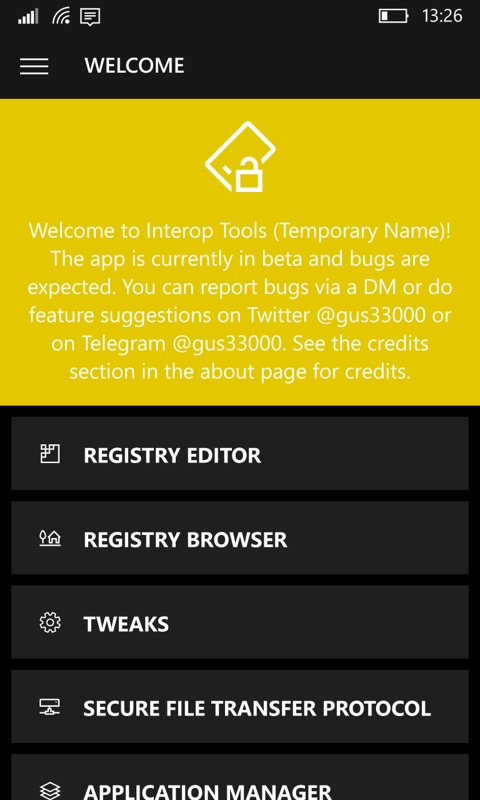
10. In the 'Registry browser', I navigated through (in turn, i.e. 4 taps) the registry key hierarchy:
- HKEY_LOCAL_MACHINE
- System
- Platform
- DeviceTargetingInfo
11. I then changed the phone's ID so that when the phone update routines come calling, it reports itself as a device that's most definitely 'allowed' to get the latest OS updates. I used the Lumia 950 XL for the ID:
- I set 'PhoneManufacturer' to 'MicrosoftMDG' (capitalisation is important). I tapped on 'Write' and then 'Write' again.
- I repeated along the same lines for 'PhoneManufacturerModelName', to 'RM-1085_11302' (or RM-1116_11258 has been suggested for dual SIM devices, again mimicking a Lumia 950 XL)
- I repeated for 'PhoneModelName', setting this to 'Lumia 950 XL'
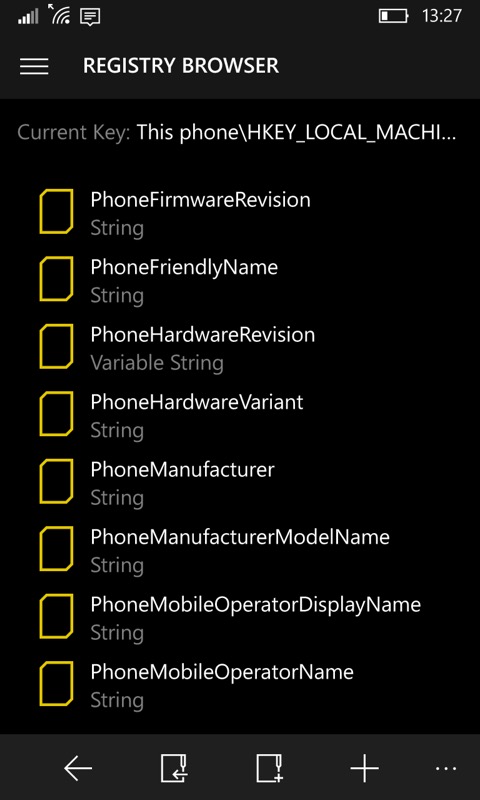

12. Heading to 'Settings/Update & Security/Phone update', I tapped on 'check for updates' and I found that Windows 10 Mobile OS branch 14393 was already downloading, as the next step for the Lumia 950 XL (should one such be found in 'original' 2015 condition!) This is the Anniversary Update and I waited the usual hour or two while this installed, the phone restarted and 'migrated', and so forth.
13. So far so good, and my test Lumia 920 was now more up to date. Now to grab the Creators Update (a.k.a. Redstone 2, branch 15063) and beyond. Waiting a few minutes while the new OS branch settled down, heading back into Settings, 15063 was already downloading.
14. In theory, I could rinse and repeat the update dance for 'Fall Creators Update' (a.k.a. 'Redstone 3 Feature 2', a.k.a. branch 15254). In practice, I was hit with the infamous '0x80070273' error when applying the update and it's at this point that I was stuck. It's not clear whether the Lumia 950 just isn't compatible with such modern OS installers, for some reason, or whether MS's servers were just having a bad day. Oh well. Your comments welcome!
Even so, after three hours(!), my 2012-made Lumia 920 had progressed from W10M circa 2015 to the Creators Update, still getting monthly updates until June 2019. Now that's longevity!
It's at this point that I'd recommend a full 'reset your phone' in Settings/System/About. If you've come up via 8.1/Threshold/AU/CU etc. and haven't yet had a chance to reset then now is the time. And don't try and restore any 'backups'. Just set up as a fresh phone after the reset and resync your data (e.g. from Microsoft or Google) in the usual way and re-install any applications needed from the Store. The OS will be cleaner and fresher that way and everything will work more reliably - trust me.
As usual, in the Store there will be a lot to update. So be patient! On the older, slower Lumias, you're looking at about an extra hour to install 50 UWP app updates - and you'll need to keep an eye on it too, as it can get paused while the Store client itself closes or gets updated. And all that's before you start installing third party apps.
So you'll need some tea. Or beer!
__________________
Caveats
Do note that there are some caveats to taking an older phone like this through to Windows 10 Mobile 'Redstone 2' (and beyond):
- Brightness is broken, with varying results that always make sense.
- Glance screen is gone, since all the registry keys that the older phone hardware need are moved competely for Windows 10 Mobile. Potentially another showstopper for some?
- Windows 10 Maps is broken, in that the map rendering code was updated in the latest versions to use hardware-accelerated graphics in the newer chipsets - using Maps on older x20 Lumias on Creators Update results in road outlines not being drawn properly. Navigation still works fine, including voice, but it's disconcerting to see much of the familiar Maps interface 'missing'!
- Camera is broken (under Creators Update on the test 920 anyway). Yes, even with third party apps and even with Skype. This is a biggie, as it (probably) prevents the phone from being used seriously in daily life. Yes, the OS and apps are now up to date, but if you can't use imaging then that's a major selling point of the Lumia gone...
Performance is smooth but slow, as you might expect on such an old device. Starting applications can take a second or two and there's definite 'lag' by 2019 standards, yet at no point do things stop working altogether (other than the caveats above).
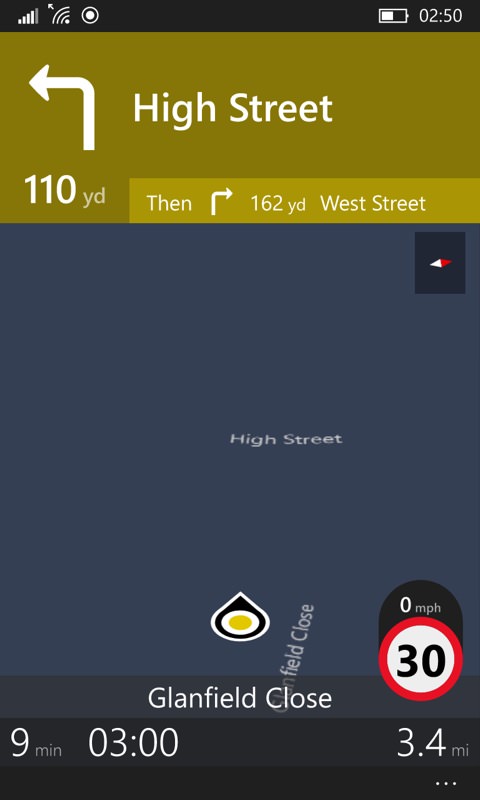
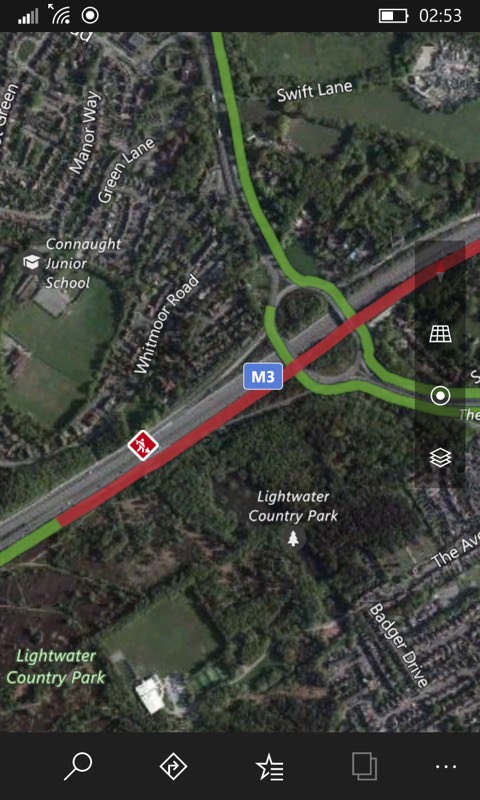
Windows 10 Maps has errr..... street rendering issues on the older phones. Navigation still works though, as do all other views, including traffic and aerial views here.

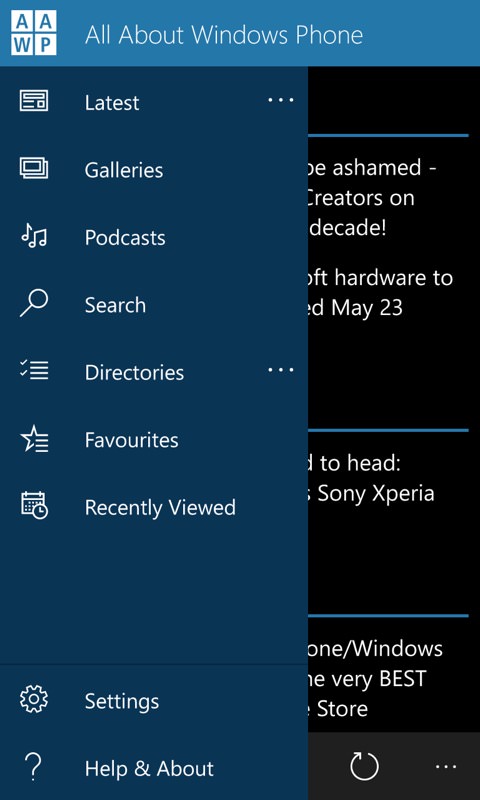
Going through the process of updating loads of built-in apps in the Store client; (right) of course, being on Windows 10 Mobile means that all the latest UWP apps are available - here with 'AAWP Universal' in action.
The 4.5" 768p screens do seem small by today's standards, yet consider the use of capacitive controls - these mean that you never have to live with virtual, on-screen controls, and so the effective interface is equivalent to a 5" screen with the latter.
At the very least, the Lumia 920, 925 and 1020 can live on the Creators Update on the whole and take part in most of what Windows 10 Mobile has to offer in 2019. 'Can'. I'm not saying that I recommend it though, not least due to the imaging issues.
PS. For the editorial 920, I'm going to revert it back to Windows Phone 8.1 in due course and play again with the OS when it was fast and snappy and elegant!
